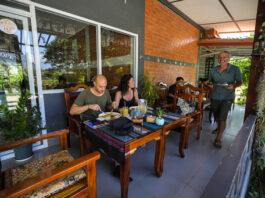DUBAI, United Arab Emirates (AP) — Iran has started up new cascades of advanced centrifuges and plans to install others in the coming weeks after facing criticism over its nuclear program, the United Nations’ atomic watchdog said Friday. The U.S. called the moves “nuclear escalations.”
Spinning up new centrifuges further advances Iran’s nuclear program, which already enriches uranium at near-weapons-grade levels and boasts a stockpile enough for several nuclear bombs if it chose to pursue them. However, the acknowledgement from the International Atomic Energy Agency did not include any suggestion Iran planned to go to higher enrichment levels amid wider tensions between Tehran and the West as the Israel-Hamas war rages in the Gaza Strip.
The IAEA said its inspectors verified Monday that Iran had begun feeding uranium into three cascades of advanced IR-4 and IR-6 centrifuges at its Natanz enrichment facility. Cascades are a group of centrifuges that spin uranium gas together to more quickly enrich the uranium.
So far, Iran has been enriching uranium in those cascades up to 2% purity. Iran already enriches uranium up to 60%, a short, technical step away from weapons-grade levels of 90%.
Iran also plans to install 18 cascades of IR-2m centrifuges at Natanz and eight cascades of IR-6 centrifuges at its Fordo nuclear site. Each of these classes of centrifuges enrich uranium faster than Iran’s baseline IR-1 centrifuges, which remain the workhorse of the country’s atomic program.
Tehran did not immediately acknowledge the decision. However, it comes after Iran threatened to take action following a vote earlier this month at the IAEA’s Board of Governors that censured Iran for failing to cooperate fully with the agency.
The decision immediately drew criticism from State Department spokesman Matthew Miller.
“Iran aims to continue expanding its nuclear program in ways that have no credible peaceful purpose,” Miller said in a statement. “These planned actions further undermine Iran’s claims to the contrary. If Iran implements these plans, we will respond accordingly.”
Miller did not elaborate on what steps the U.S. and its allies might take. However, Iran already faces grinding economic sanctions from Washington and others that have deeply cut into its economy and sent its rial currency tumbling over recent years.
Since the collapse of Iran’s 2015 nuclear deal with world powers following the U.S.’ unilateral withdraw from the accord in 2018, it has pursued nuclear enrichment just below weapons-grade levels. U.S. intelligence agencies and others assess that Iran has yet to begin a weapons program.
Iran, as a signatory to the Treaty on the Non-Proliferation of Nuclear Weapons, has pledged to allow the IAEA to visit its atomic sites to ensure its program is peaceful. Tehran also agreed to additional oversight from the IAEA as part of the 2015 nuclear deal. However, for years it has curtailed inspectors’ access to sites while also not fully answering questions about other sites where nuclear material has been found in the past.
The IAEA’s director-general, Rafael Mariano Grossi, visited Iran in May in an effort to boost inspections, but there hasn’t been any major public change in Iran’s stance.
All this comes as the Islamic Republic also appears to be trying to contain the risk it faces from the U.S. after launching an unprecedented attack on Israel. The assault — a response to a suspected Israeli strike on April 1 which killed two Guard generals and others in Damascus, Syria — has pushed a yearslong shadow war between Israel and Iran out into the open.
Home World Live Israel-Hamas War Iran installing and starting cascades of advanced centrifuges as tensions high over...
